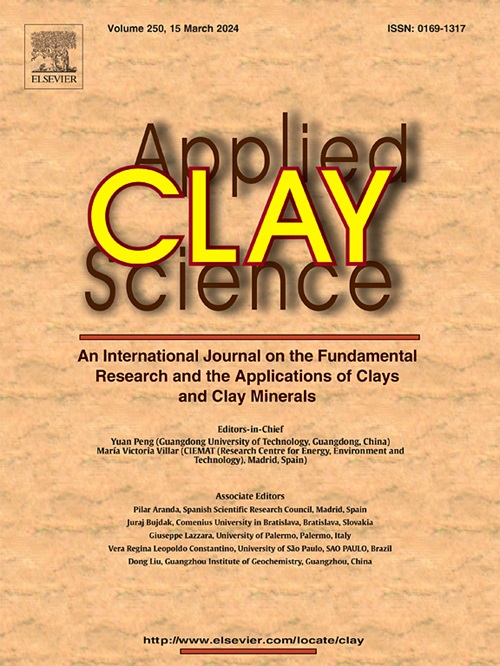Structure–property correlations for PEG-interpenetrated hybrids of poly(acrylamide-co‑sodium acrylate) reinforced with Laponite, halloysite, sepiolite and montmorillonite
IF 5.3
2区 地球科学
Q2 CHEMISTRY, PHYSICAL
引用次数: 0
Abstract
This study investigates the impact of different clay types on the properties of clay polymer nanocomposites (CPNs). semi-interpenetrated (semi-IPN) cryogels consisting of poly(acrylamide-co‑sodium acrylate)/poly(ethylene glycol) (PAN/PEG) and various clay minerals such as Laponite, sepiolite, halloysite, and montmorillonite were prepared following “in situ” synthetic protocol. The aim was to determine most effective inorganic component for developing desired elasticity and swelling/shrinking ability. By fixing the concentration of clay minerals embedded in CPNs as 1.50 % (w/v), the effect of inorganic clay type on structural properties was evaluated in terms of polymerization temperature, compressive elasticity, pH and thermo-sensitivity. Clay type had an effect on the thermal stability of semi-IPNs, while sepiolite increased the stability and compressive modulus to a higher extent. Among the four types of semi-IPNs, the water absorbency of montmorillonite-integrated gel was the highest, while that of sepiolite-doped was the lowest. The elastic moduli of semi-IPNs incorporated with same amount of clay is in the order Sepiolite > Halloysite > Laponite > Montmorillonite. Changing pH in the range of 2.1 to 11.2 significantly increased the swelling, while a small variation in pH 6.6 caused a large difference in swelling capacity. For pH-dependent cyclic swelling, the highest swelling-shrinkage response was observed in Laponite-doped cryogels. The swelling of nanocomposites was significantly weakened by the change in ionic strength, while the swelling increased with the incubation temperature, showing good agreement with Fickian diffusion. Among the nanocomposites for cationic methylene blue (MB) dye, Laponite-integrated semi-IPNs exhibited the highest adsorption capacity from aqueous solution with 89.51 mg/g. MB adsorption kinetics followed pseudo-second-order, Freundlich and Redlich–Peterson isotherm models. The findings provide strategic approach for promising material design, supporting the development of potential applications of polyelectrolyte semi-IPN nanocomposite cryogels as biomedical materials.

拉脱土、高岭土、海泡石和蒙脱土增强聚丙烯酰胺-丙烯酸钠聚丙烯腈互穿杂合体的结构-性能相关性
研究了不同粘土类型对粘土聚合物纳米复合材料(CPNs)性能的影响。采用原位合成工艺制备了由聚丙烯酰胺-丙烯酸钠/聚乙二醇(PAN/PEG)和拉脱土、海泡石、高岭土、蒙脱土等多种粘土矿物组成的半互穿式(半ipn)冷冻材料。目的是确定最有效的无机成分,以发展所需的弹性和膨胀/收缩能力。通过将黏土矿物包埋在cpn中的浓度固定为1.50% (w/v),从聚合温度、压缩弹性、pH和热敏性等方面评价了无机黏土矿物类型对cpn结构性能的影响。粘土类型对半ipns热稳定性有影响,海泡石对稳定性和压缩模量有较大的提高作用。在四种半ipn中,蒙脱石集成凝胶的吸水率最高,海泡石掺杂凝胶的吸水率最低。掺入等量粘土的半ipns弹性模量为海泡石>;埃洛石比;Laponite祝辞蒙脱石。pH值在2.1 ~ 11.2范围内变化会显著增加溶胀量,而pH值在6.6范围内变化较小,溶胀量差异较大。对于ph依赖的循环膨胀,在拉孔石掺杂的冷冻液中观察到最高的膨胀-收缩响应。随着离子强度的变化,纳米复合材料的溶胀性明显减弱,而随着培养温度的升高,溶胀性增强,符合菲克扩散规律。在阳离子亚甲基蓝(MB)染料的纳米复合材料中,拉孔石集成的半ipns对水溶液的吸附量最高,为89.51 mg/g。吸附动力学符合拟二阶Freundlich和Redlich-Peterson等温模型。这些发现为有前途的材料设计提供了战略方法,支持了聚电解质半ipn纳米复合低温材料作为生物医学材料的潜在应用的发展。
本文章由计算机程序翻译,如有差异,请以英文原文为准。
求助全文
约1分钟内获得全文
求助全文
来源期刊

Applied Clay Science
地学-矿物学
CiteScore
10.30
自引率
10.70%
发文量
289
审稿时长
39 days
期刊介绍:
Applied Clay Science aims to be an international journal attracting high quality scientific papers on clays and clay minerals, including research papers, reviews, and technical notes. The journal covers typical subjects of Fundamental and Applied Clay Science such as:
• Synthesis and purification
• Structural, crystallographic and mineralogical properties of clays and clay minerals
• Thermal properties of clays and clay minerals
• Physico-chemical properties including i) surface and interface properties; ii) thermodynamic properties; iii) mechanical properties
• Interaction with water, with polar and apolar molecules
• Colloidal properties and rheology
• Adsorption, Intercalation, Ionic exchange
• Genesis and deposits of clay minerals
• Geology and geochemistry of clays
• Modification of clays and clay minerals properties by thermal and physical treatments
• Modification by chemical treatments with organic and inorganic molecules(organoclays, pillared clays)
• Modification by biological microorganisms. etc...
 求助内容:
求助内容: 应助结果提醒方式:
应助结果提醒方式:


